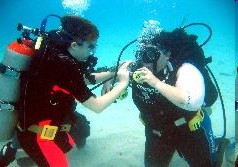The final question everyone asks. Unfortunately, there is no short answer to this question, and the usual response is: it all depends. After the strange looks, I start to explain some physics and physiology, and lose most people after a few sentences.
Let’s start out by changing the question. Why do you get out of the water? Without getting too deep into the physics / physiology and finances, we have one of several reasons:
1) Limited ability to withstand the temperature drain of water immersion
2) Limits on the amount of gas we have
3) Large fish with teeth
Normally, 1 and 2 are the major limiting factors. Inflatable Water Slide When the original question is posed, it is usually referring to our gas limits, so let’s look closer at the factors affecting it.
Without getting too deep into the explanation, lets just use a couple of generalizations.
1) The deeper you go, the less time you have.
2) The harder you work (underwater) the less time you have.
3) Different people consume air at different rates.
4) The bigger you are, the less time you will have.
5) New divers will have less time than experienced divers.
Numbers 1 and 2 are immutable facts. Numbers 3 – 5 are generalizations that vary greatly based on the individual, their physical fitness, and level of skill and comfort in the water.
Just to throw a wrench into the works, we must also consider the size of the tank. As discussed before, different tanks carry different amounts of gas, and can allow us to stay longer.
Let’s consider an average dive (not working hard), by an average diver at an average depth (60 ft) with the average tank (Aluminum 80). In general this diver should have gas to dive for about an hour.
 This is a another common question along with: How do you learn to dive? How long does it take?
This is a another common question along with: How do you learn to dive? How long does it take?